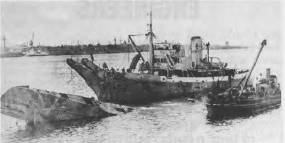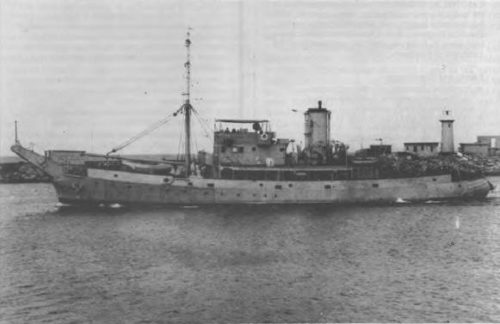- Author
- Weaver, Trevor and Jeffrey, Vic
- Subjects
- Ship histories and stories
- Tags
-
- RAN Ships
- HMAS Karangi, HMAS Kimbla
- Publication
- September 1990 edition of the Naval Historical Review (all rights reserved)

Fairly recently a photo of HMAS Karangi shown raising a submarine was received from the RAN Naval Collection. This photo was very interesting as it was definitely not snapped in Sydney Harbour, so where was it taken? As it turned out Karangi was photographed in Fremantle Harbour during 1946 and she was raising the former Dutch submarine K.XI.
K.XI was one of the seven Dutch submarines to escape from Java in the Dutch East Indies ahead of the advancing Japanese in 1942. Three of these submarines escaped to Fremantle, Western Australia, those being K.VIII, K.IX and K.XII, whilst four others including K.XI escaped to Colombo in Ceylon. After an active war career K.XI arrived in Fremantle on the 22nd March, 1945.
K.XI paid off at Fremantle on the 10th April, 1945 and was handed over to the RAN at Fremantle for transfer to the disposal committee on the 21st June. As the submarine was so old, built in 1925, no longer wanted by the Dutch or Australian governments she was taken up the Swan River to “LEEUWIN 3”, the Royal Freshwater Bay Yacht Club, where she was partially stripped. Shortly after this in 1946 she was sold locally and further stripping of the submarine continued near the Fremantle Slipway. As a result of a depth gauge being left off the hull, the submarine took in water and sank alongside. Karangi was employed in the salvage of K.XI after divers sealed the hull. Finally in September, 1946 the former K.XI was towed out of harbour, and some 12 miles west of Rottnest Island was scuttled.

HMAS Karangi was a familiar sight in West Australian waters during the 1940s and 50s. Shortly after commissioning in 1941, Karangi together with her sister ships Kangaroo and Koala operated out of Darwin in the Northern Territory. From Darwin Karangi proceeded to Fremantle, remaining there till August 1952, when she departed for an extended refit in Sydney before returning to the West again. Apart from raising the hulk of K.XI, Karangi was kept busy postwar in Western Australian waters. Her everyday routine was shattered on 7th January, 1952 when an engine room explosion injured six sailors.
The ship was berthed alongside Fremantle’s North Wharf at the time of the accident and the six sailors suffered only slight burns. In the explosion an extra feedwater tank was blown to pieces. The force of the blast broke glass in the skylight and sent it flying in all directions. One of the injured sailors had been struck above the eye by a fragment and received a deep laceration. He had been standing on the quarterdeck. It was astonishing that there had been no loss of life or serious injury as the steel framework of the skylight was buckled and the awning over the quarterdeck was blown off when the tank shattered.
Karangi operated under the operational control of Western Australia Area Command till she paid off on 30 September, 1954. During 1952, Karangi was present at the British atomic tests at the Monte Bello Islands. Her last Commission was from April 1955 to 31st May, 1957 when she paid off for the last time. All three of the Kangaroo Class together with the older Boom Defence ship Kookaburra, which paid off in 1958, remained in reserve in Sydney Harbour till they were disposed of in the mid 1960s.
These ships together with their half sister HMAS Kimbla often carried out mundane duties, were largely unheralded but were important units of the Royal Australian Navy that quietly and efficiently carried out duties allocated to them. They were not fast ships, in fact they were very slow, nor were they very beautiful ships but they did their designed job and more and did it well.




